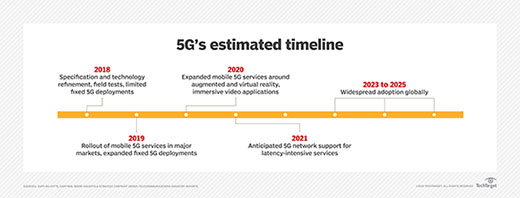- Share this item with your network:
- Download
Network Evolution
- FeatureNew 5G wireless technology trials spark enterprise interest
- FeatureSmall SDN providers' cost, flexibility appeal to enterprises
- FeatureConsolidating overlapping tools for enterprise collaboration
- FeatureEngineer uses Cisco DNA Center to combat network challenges
- OpinionThe sky's the limit with 5G wireless communication

chris - Fotolia
New 5G wireless technology trials spark enterprise interest
New 5G wireless technology promises super-fast network speeds and massive capacity. Businesses that require low latency and high throughput could see the advantages first.
The fifth generation of wireless technology is moving steadily toward the enterprise, as the telecom industry expects the 5G rollout to have a massive economic impact on how business is conducted across the globe. As network operators increase their 5G testing in 2018, and standards organizations continue to hammer out 5G specifications, business customers are getting interested in what's in 5G for them.
Although 5G wireless technology is still in development, network analysts and forward-thinking businesses are banking on the promise of faster wireless network speeds and greater capacity. Telecommunications carriers will continue testing their 5G wireless products and 5G fixed broadband services throughout 2018 and hope to begin commercial deployments in 2019, with 5G-enabled smartphones and devices available by 2021. Overall, widespread use of commercial mobile 5G services probably won't arrive until 2025.
Even though it's early in the development process, enterprises can expect 5G to improve productivity and business efficiency with enhanced wireless broadband speed and capabilities, according to Will Townsend, an analyst with Moor Insights & Strategy in Austin, Texas.
New 5G services for businesses and consumers will roll out in stages, Townsend said. This year, some telecom providers plan to pilot precommercial 5G fixed wireless consumer broadband services, which use wireless network technology rather than fixed lines.
Currently, telecommunications carriers operate 4G networks that include LTE, LTE-Advanced and Advanced Pro. At peak 4G speeds, mobile devices can exchange data from 100 Mbps up to 1 Gbps. New 5G technology promises peak speeds up to 10 Gbps. That kind of massive improvement in speed over 4G is the key to unlocking the advantages of 5G wireless technology, Townsend said.
Preparing for 5G in the enterprise
For industries like healthcare, financial services, energy and other field-service organizations that require low latency and high throughput, 5G will make a significant impact, Townsend said.
Businesses that have specialized communications requirements, like internet of things applications, self-driving cars and some manufacturing processes, might see benefits from 5G wireless technology before others do, according to Sundeep Rangan, Institute of Electrical and Electronics Engineers fellow and associate professor at the New York University Tandon School of Engineering. "If 5G can be combined with other teleconferencing technologies, particularly virtual reality and augmented reality, we may see a dramatic improvement in business communication."
Some enterprises starting to prepare for 5G wireless technology are appointing C-suite leaders and other IT managers to look at the internet of things and other potential applications that can take advantage of 5G capabilities, Townsend said. Having someone focus on the technology and study 5G right now is the best way to prepare, he added.
One business embracing 5G readiness sooner than others is Odessa Medical Center Health System, based in Odessa, Texas, a 28-facility organization with a staff of more than 2,250. The medical center has 5G on its radar as something for the future, according to IT director Brad Shook. To prepare for 5G wireless technology, the medical center that serves a 17-county region upgraded its wireless network in 2016. The medical center saw the need at that time to prepare for 5G wireless technology, Shook said. When 5G devices are in use, the Odessa network will be able to support them.

Increased bandwidth and speed will help hospital departments like radiology, for example, which sends massive amounts of data to its picture archiving and communication system, Shook added.
One big advantage of 5G is its support for network slicing, where operators can partition a single 5G network into several isolated virtual slices for its enterprise customers, each slice serving a different business service, Townsend said.
Telehealth increasingly is used to connect physicians to patients in remote locations, for example. Telesurgery requires low-latency, high-speed connections that are available in real time. Eventually, a hospital will be able to use 5G to slice its networks, Townsend said. One slice could manage telesurgery, sending massive amounts of video data to a remote location, for example, while another slice could be supporting more routine work at a nurse's station or a hospital's wireless guest access to ensure its other business segments have separate and secure virtual network slices of their own.
Operators advancing on 5G wireless technology
Network slicing is only one component of the new service-based architecture taking shape through 5G standards development, according to the 3rd Generation Partnership Project (3GPP). The 3GPP brings together seven standard development organizations to create specifications for cellular telecommunications network technologies.
In late 2017, 3GPP announced a new 5G service-based model for network operators. The organization said the model adopts principles like modularity, reusability and self-containment of network functions and was chosen so deployments will be able to take advantage of the latest virtualization and software technologies. The greater agility from the model will help operators respond more quickly to their business customers' needs, according to the 3GPP.
The organization plans to deliver more 5G specifications in June 2018.
In addition to the standards work, Verizon will continue testing 5G networks, expanding to 11 major metropolitan areas this year, and plans to demonstrate the capabilities of 5G wireless technology at the 2018 Winter Olympics in Pyeongchang, South Korea.
For its part, AT&T has expanded its 5G fixed wireless tests to include Magnolia, a home and lifestyle brand at its shopping location called the Silos in Waco, Texas. AT&T is testing millimeter wave spectrum to distribute connections throughout the location via Wi-Fi. It will also test 5G radio and antenna prototypes and is using AT&T FlexWare, its network functions virtualization product, as the router for the 5G network. AT&T said it hopes faster wireless speeds will benefit employees who use mobile point-of-sale devices and wireless devices to manage back-office operations, in addition to consumer shoppers.
Many trials have to be completed before network operators make 5G services commercially available. In addition to pilot projects and standards development, federal and state access regulations and local permitting have to be established that allow telecommunications companies to install more fiber. Additional fiber is needed to meet the data demands that will come with 5G, according to Tom Nolle, president of CIMI Corp., a consulting firm specializing in telecommunications and data communications.
The need to install fiber closer to the consumer's location, where connections could be completed by 5G wireless connections, explains why new capacity is required, Deloitte wrote in its July 2017 communications infrastructure upgrade report.
For now, telecommunications carriers and operators are bearing the brunt of 5G investment. Eventually, businesses will have to consider spending on fiber upgrades and other physical equipment to upgrade to 5G. But IT managers aren't yet making strategic commitments to 5G products or services they can't even buy yet, Nolle said. "It's too far out."
Future of 5G
Users' capacity for data consumption is at the heart of the 5G issue.
With mobile devices being used to access more data, 5G could have the greatest impact in the enterprise data center, according to Craig Mathias, principal with Farpoint Group, a wireless and mobile advisory firm in Ashland, Mass., adding that 5G wireless broadband services will be able to handle a variety of traffic demands and applications. Still, the ramp up of 5G adoption probably won't start until 2023, he added. Because organizations have different time frames and strategies, 5G implementation isn't one-size-fits-all.
Eventually, organizations will have to contend with the data demand from 5G-equipped devices, which will put a strain on data centers. But higher wireless capacity will lead to far fewer bottlenecks from more demands on the data center, he said.
As the business cases for 5G evolve, enterprises will find new ways to take advantage of 5G wireless technology. Eventually, if telecommunications carriers can achieve true 5G ubiquity, 5G could someday replace Wi-Fi all together, Townsend said.
In the meantime, enterprises can consider increased fiber and 5G device investments and prepare for staged rollouts of fixed 5G wireless services, followed by mobile cellular services.







